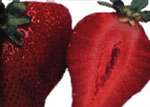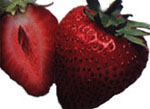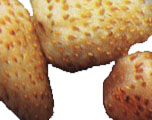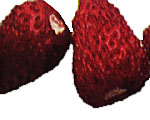


White Fraises des Bois Red


FoodFood InformationFruitBerries
Wild strawberries, which are also known as wood strawberries, have all
but disappeared in the United States, though they are still commercially
cultivated on a small scale in the Alpine areas of Europe and in season
they grace the tables of fine restaurants in France. The tiny wild berries
are long on flavor and fragrance.
The commercially grown strawberry we find in our retail stores are much
larger and more abundant than the wild strawberries, but they aren't quite
as fragrant and flavorful. However, we are continually producing new improved
varieties and it is probably only a matter of time before we perfect strawberries
that are as big as golf balls and will match the aroma and the taste of
the wild berries.
Not only are today's berries superior to those that were available twenty
or thirty years ago, they are in season for much longer periods of time.
In areas north of the Mason-Dixon Line, the strawberry season once lasted
only from early spring to the Fourth of July. Today, fine strawberries are
available twelve months of the year.
Strawberries are grown in all fifty states, including Alaska. In most areas
the strawberry season is about three months in duration. However, California
strawberries are in season eleven months of the year and are even available
in very limited supply during the month of December.
California is strawberry country. They grow more strawberries than anywhere
else in the world and each year they add to the acreage used to grow the
berries. With ideal climate and soil conditions, California produces more
than 75 percent of the total United States crop. The berries thrive in sunny,
coastal regions, where the days are warm but not torrid and the nights are
cool and damp. California gets a tremendous yield per acre, seven times
the average yield of the rest of the strawberry-growing areas in the country.
They not only supply most of the North American market but also export to
all the major cities of the world. In 1984 the size of the crop was a mind-boggling,
record breaking 560 million pounds, almost a 50 percent increase over the
previous year.
While strawberries are shipped eleven months of the year, the peak of their
season is from April 15 to July 15. During that period the finest berries
of the year usually sell at the lowest prices of the year.
Florida is a very distant second to California in total production, and
even at their best the Florida berries are no match for the best berries
from California. However, beginning in December, Florida strawberries take
up the slack for about six weeks, until the new crop of California berries
comes on line. During the winter months we also import strawberries from
New Zealand, Israel, and Mexico.
The quality of those berries air-freighted from New Zealand and Israel is
quite good, but they are usually expensive. The Mexican berries arrive via
truck and as a rule do not win any blue ribbons; however, they are usually
not very costly.
The expensive, imported, out-of-season strawberries, even though they cost
five dollars or more per pint, aren't nearly as good as the marvelous California
berries that sell for well under a dollar a pint during May and June.
Select firm, dry, shapely, glossy, dark red berries that have fresh green
caps. Strawberries ripen no further after harvest, what you see is what
you get. Fine berries that meet the above criteria, if stored under refrigeration,
can last for about a week without too much wear and tear. However, it is
wiser to use them as soon as possible after purchase to enjoy top flavor
and nutritional value.
Avoid strawberries (or any other berries) that are soft, wet, or show any
trace of mildew. Also avoid those that are pale in color or have white shoulders.
Until about ten years ago, the smaller- and medium-sized strawberries were
more flavorful than the larger, usually more costly, berries. The bigger
berries used to be hollow and less juicy. However, today's new large varieties
have both size and flavor. Occasionally you may see very large strawberries
with string like stems attached. These stem berries are a gourmet item that
is highly overpriced. Unless you want these berries to dip in melted chocolate,
or even in powdered sugar, at a dinner party, you can purchase equal or
even better strawberries at less than half the price.





WHEN TO BUY: At peak April, May, and June
WHAT TO LOOK FOR: Firm, dry, dark red berries; size has little bearing on
quality
HOW TO STORE: Refrigerate immediately
Deamer 5/97